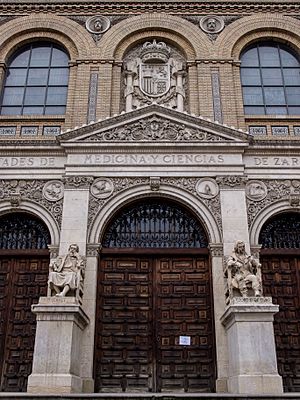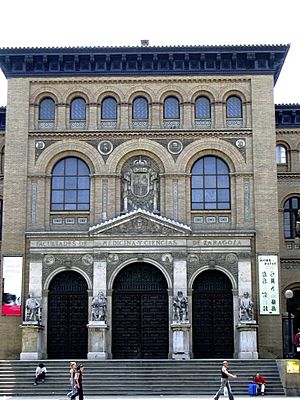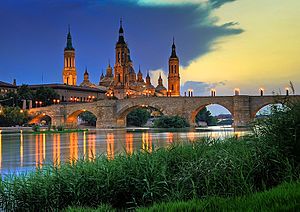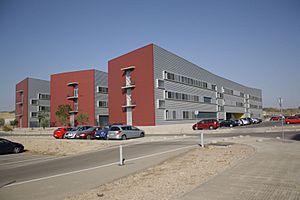University of Zaragoza facts for kids
|
Universidad de Zaragoza
|
|
 |
|
| Type | Public university |
|---|---|
| Established | As the School of Zaragoza (7th century) University of Zaragoza in 1542 |
| Rector | Rosa María Bolea Bailo |
|
Academic staff
|
3,911 (2013–2014) |
|
Administrative staff
|
1,806 (2013–2014) |
| Students | 36,492 including self-study and international participants (2013–2014) |
| Undergraduates | 30,415 (2013–2014) |
| Postgraduates | 3,528 (2013–2014) |
| Location |
,
Spain
41°38′31″N 0°54′05″W / 41.64206390°N 0.90150650°W |
| Campus | Jaca, Huesca, La Almunia de Doña Godina, Zaragoza, Teruel |
 |
|
The University of Zaragoza (also known as Spanish: Universidad de Zaragoza) is a big public university in Spain. It has campuses and research centers across the three provinces of Aragon: Zaragoza, Huesca, and Teruel.
This university was officially started in 1542, making it one of the oldest universities in Spain. Its history goes back even further, to the time of the Romans.
Many famous people have studied here. These include Prime Ministers like Manuel Azaña, a Nobel Prize winner named Santiago Ramón y Cajal (who is called the father of modern neuroscience), and even the Cuban national hero Jose Marti.
Around 2014, the university had over 30,000 students and more than 3,000 teachers. It offered 74 different degrees across 22 centers. The current head of the university is Rector José Antonio Mayoral Murillo.
Contents
History of the University
How it Started
The University of Zaragoza began with church schools. These schools grew into the School of Zaragoza, led by Bishop Braulio in the 7th century. Bishop Braulio is now the university's patron saint.
The School of Arts officially became a university in 1542. However, some experts believe it was already acting like a university for arts as early as 1477.
Early Days and Learning
The first main building for the university was a large round tower on the old city wall. It had many rooms for students and teachers. There was a special room where students received their degrees and a library. The university also had a prison, which was common for universities back then.
The head of the university was the chancellor, who was always the archbishop of Zaragoza. The vice-chancellor was second in command and also the main teacher. Teachers included masters of arts, who taught subjects like philosophy, and others who taught Latin grammar and basic Latin.
The early university had a Faculty of Arts, which included logic and philosophy. It also had a Faculty of Grammar, which was very popular with hundreds of students in the early 1500s. To get a degree, students had to pass exams and pay fees.
One important teacher was Gaspar Lax, who became the main teacher in 1520. He was famous in Europe for his work in logic, philosophy, and math. He even allowed the works of the famous scholar Erasmus to be taught at the university. Michael Servetus, a brilliant student and Gaspar Lax's nephew, also studied here.
Modern University Life
Today, the University of Zaragoza is a key place for new technology and ideas in the Ebro Valley. It is well-respected among universities in Spain and around the world.
The teachers at the university are highly skilled in their fields. They have a lot of experience in both teaching and research. Students can study many interesting subjects, like Spanish as a foreign language, Spanish literature, history, and even new areas like biocomputation and nanotechnology.
The university has about 40,000 students, 3,000 teachers, and 2,000 staff members. It has campuses in Zaragoza, Huesca, and Teruel.
University Campuses
The University of Zaragoza has campuses in the Community of Aragon in Spain. Aragon has three provinces: Zaragoza, Huesca, and Teruel. The main campus is in Zaragoza, but new campuses were opened in Huesca and Teruel in 1985.
Zaragoza Campus
The Zaragoza campus is split into five different areas within the city. The largest area is Campus Plaza San Francisco, where most of the university's colleges and departments are located. The other four areas, Campus Rio Ebro, Escuela Universitaria de Turismo, Plaza de Basilio, and Facultad de Veterinaria, each host one or two colleges.
The Paraninfo building, located on the San Francisco campus, is one of the university's most important buildings. It first opened in 1893 and was restored in 2006. The King of Spain and other important people attended the reopening. The architects worked hard to keep the building's original look while adding new features. Outside the building, there are four large stone statues of famous scientists and doctors who were connected to the university, including Miguel Servet. Today, the Paraninfo is an auditorium and the main University of Zaragoza Library.
Huesca Campus
Huesca is about 75 kilometers (47 mi) northeast of Zaragoza. The Huesca campus has several colleges, including the Polytechnic School, the Faculty of Health and Sport Science, and the Faculty of Humanities and Education. There is also a nursing school linked to the San Jorge hospital in Huesca.
Teruel Campus
Teruel is about 170 kilometers (110 mi) south of Zaragoza. The Teruel campus is home to the technical college, where students can study computer engineering and similar programs. It also has the Faculty of Social and Human Sciences and a nursing school connected to the Obispo Polanco hospital.
What You Can Study
At the University of Zaragoza, traditional subjects are taught in faculties (facultades), like the Faculty of Law (Facultad de Derecho). Newer, more technical subjects are offered at schools (escuelas) or polytechnics (politécnicos), such as the 'University School for Technical Engineering'.
Learning Spanish
The university offers courses in Spanish for international students throughout the year. These courses range from 90 to 570 hours and cover all levels, plus some special topics. During the school year, courses are in Zaragoza, while summer courses are held in Jaca in the Pyrenees mountains. The University of Zaragoza was the first Spanish university to offer Spanish courses for international students, starting in 1927.
Research and Innovation
The University of Zaragoza explores many different areas of knowledge. These include engineering and technology, science, health, social sciences, and humanities.
In 2010, the university had six research institutes and several joint research centers. At that time, it spent about €60 million each year on research and development. By 2011, the university had around 3,803 researchers and worked with 8,305 companies.
Cancer Research
The University of Zaragoza is a world leader in immunotherapy cancer research. Teams led by Julián Pardo, Luis Martinez, and Alberto Anel have made important discoveries about how cancer cells affect the body's immune system. They also have many patents for new cancer treatments.
MIT–Zaragoza Logistics Program
The Massachusetts Institute of Technology (MIT) and the University of Zaragoza created an International Logistics Program in 2003. This program works with the PLAZA logistics park, which is the largest logistics park in Europe.
The program offers a master's degree in supply chain management, similar to MIT's program. It is taught in English and attracts students from all over the world. This program has been named the #1 logistics and supply chain management degree in Spain by El Mundo newspaper for several years. The program also offers a doctorate degree and short courses for professionals. Researchers use the logistics park as a real-world lab to test new ideas in logistics.
University Rankings
| University rankings | |
|---|---|
| Global – Overall | |
| ARWU World | 601–700 (2023) |
| QS World | =523 (2024) |
| THE World | 801–1000 (2024) |
| USNWR Global | =676 (2023) |
El Mundo rankings of Spanish master programs (2014–2015)
- #1 Logistics and supply chain management
- #2 Environmental energy
(2013–2014)
- #1 Education
- #1 Logistics and supply chain management
- #2 Environmental energy
Academic Ranking of World Universities (ARWU) (2013)
- #9–10 top universities in Spain
CWTS Leiden Ranking (Spain) (2014)
- #3 Social sciences (impact)
- #3 Medical sciences (collaboration)
- #3 Cognitive sciences (collaboration)
- #14 All sciences (impact)
- #14 All sciences (collaboration)
See also
 In Spanish: Universidad de Zaragoza para niños
In Spanish: Universidad de Zaragoza para niños
- List of medieval universities
- List of University of Zaragoza people




